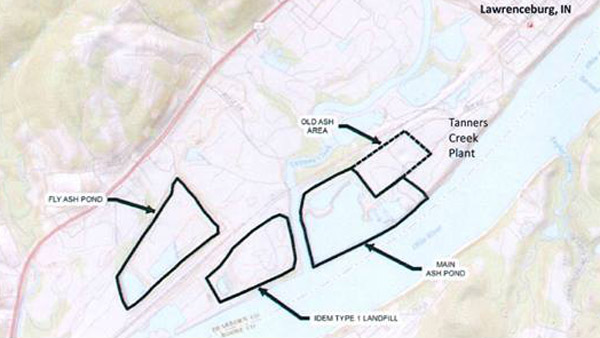Four Indiana environmental organizations say Tanners Creek Development LLC's plan to close a fly ash pond in place will present an ongoing risk to local drinking water.

A map of the ash pond complex at the former Tanners Creek Power Plant site in Lawrenceburg, Indiana. Image by Tanners Creek Development LLC.
(Lawrenceburg, Ind.) – Four environmental groups are joining local citizens in asking the Indiana Department of Environmental Management to delay the closure of a coal ash pond in Lawrenceburg.
Indiana leads the nation with more than 80 fly ash pits. Each pose a risk to people and the environment, as fly ash is known to contain poisonous metals such as arsenic, boron, lead, cadmium, chromium and others.
But the fly ash ponds in Lawrenceburg deserve heightened attention, says Tim Maloney, senior policy director with the Hoosier Environmental Council.
“There are maybe a couple of the sites among the many sites in Indiana where the potential risk to public drinking water supplies is so apparent. Your public water supply wells are literally next door to these coal ash dumps and that poses a risk,” Maloney explains.
Tanners Creek Development LLC has been redeveloping the former Tanners Creek Power Plant brownfield site since purchasing it in 2016, a year after the coal-fired generating station was decommissioned by American Electric Power’s Indiana & Michigan Power. The 725-acre tract located in the City of Lawrenceburg is now being eyed by Ports of Indiana as a potential home of the state’s fourth inland port.
But millions of tons of fly ash are buried in the facility’s four fly ash storage areas not far above the aquifer. One pond is bottom-lined with a PVC layer, but the others are not. Supply wells within a mile downstream pump drinking water for Aurora Utilities and Lawrenceburg-Manchester-Sparta Conservancy District customers.
“In Indiana, at every utility facility where there is an unlined coal ash pond, there is groundwater contamination. It is not speculative that it happens. It is happening,” Maloney asserts.
The situation has entered the Dearborn County collective consciousness since Tanners Creek Development’s proposal to ship in out-of-state coal ash to complete filling the Lawrenceburg ash pond was denied by IDEM amid public outcry. The matter has sparked social media rants, crowded and contentious meetings, and placed public officials on the defensive.
Tanners Creek Development submitted to IDEM a closure plan for the fly ash pond earlier this year. IDEM requested more information, which Tanners Creek Development submitted June 26 in a revised, 619-page closure plan.
The revised plan’s public comment period expired last month, but not before dozens of area citizens submitted comment letters calling on IDEM to deny the closure plan altogether.
A letter was also submitted July 10 by four of the state’s leading environmental organizations: The Hoosier Environmental Council, Lower Ohio River Waterkeeper, Hoosier Chapter of the Sierra Club, and Citizens Action Coalition. In the correspondence, the groups warn that the coal ash ponds are located in a high-risk and vulnerable location.
According to the group letter, water contamination is already occurring as evident in samples from monitoring wells surrounding the fly ash pond. Concentrations of arsenic, a carcinogen, are above the maximum contaminant level for the element. Boron has not exceeded a health advisory level, but is high enough to suggest coal ash contamination of the water.
The letter states that no groundwater sampling results are available for the aquifer directly below the ash pond.
Although it was established in 1970s before ash ponds were subject to such regulations, the fly ash pond is bottom-lined with a PVC liner meant to keep ash contaminants from seeping into the groundwater below.
However, other ash areas – known as the main ash pond and old ash area – are not lined and are already sitting in groundwater. Tanners Creek Development officials have said that closure plans for those areas are being designed and expected to be ready in 2020.
The environmental organization letter states that the segmented closure process has resulted in an incomplete picture of the groundwater contamination risks for IDEM and local communities. In 2015, AEP Indiana & Michigan Power submitted a consolidated closure plan for the fly ash pond, main ash pond, and old ash area.
“This outcome serves to inappropriately limit the state’s and the public’s consideration of whether the proposed closure-in-place approach will or will not threaten the drinking water supply for virtually every community in this area,” the environmentalists’ letter states.
The letter also contends Tanners Creek Development has not adequately assessed the groundwater at the site. Any present or future contamination which could threaten the Aurora and LMS water supply or the Ohio River is also not being watched close enough.
“It is not sufficient that the water utilities conduct sampling at their own wells; by the time they detect a problem, it may be too late to protect the safety of the water produced by their wells,” the groups tell IDEM.
Pointing to conditions at discontinued coal ash disposal sites in Tennessee and Georgia, the coalition says closing the fly ash pond in place will not prevent continued contamination. The Lawrenceburg pond’s location in the Ohio River floodplain makes the dried, buried ash susceptible to re-saturation when the river floods. The berms forming the pond could be damaged, environmentalists argue.
According to its revised closure plan, Tanners Creek Development has estimated the cost of the fly ash pond closure at about $7.1 million. However, the environmental organizations say, the company has failed to consider the cost of possible corrective action when evaluating the closure cost.
“The cost of decades of groundwater corrective action could make a significant difference in the total closure and post-closure cost for the Tanners Creek Fly Ash Pond. If that cost is taken into account, is closure in place still the most cost-effective approach?”
The company, they say, is not considering alternatives to simply capping the ash pond as it lay. The most protective storage of the ash is in a dry, lined landfill on high ground with a leachate collection system. In other states, utilities are reducing the threat of ash ponds by excavating ash from at-risk storage ponds or recycling the substance for use in concrete.
In all, the letter writers state, the closure plan violates Indiana’s regulations meant to protect human health and the environment.
Maloney says the groundwater testing data needs a hard look by IDEM and the local community because of the risk the nearby fly ash storage poses to water supply wells. He suggests local leaders also share their concerns about drinking water with IDEM.
“Ideally, they should be asking Tanners Creek to move the ash out of that site. That’s the only way they will have a guarantee that those drinking water wells will be protected,” says Maloney.
The Hoosier Environmental Council policy director said cities, utilities, and citizens could also pursue legal recourse if they determine there is a risk.
IDEM’s commissioner will have the ultimate decision on whether to approve Tanners Creek Development LLC’s closure plan.
Utilities and companies who own the ash ponds and landfills are moving to close the pits that do not meet design requirements in the U.S. Environmental Protection Agency’s coal combustion residual rules, or CCR rules. The rules require ash disposal areas be designed to prevent the harmful contents from entering nearby water supplies.
Utilities previously had until April 30, 2019 to close their leaking coal ponds and landfills, if additional testing finds contamination endangering groundwater. The EPA then announced July 30 that deadline has been pushed back 18 months until October 31, 2020.
RELATED STORIES:
Tanners Creek Development, IDEM Answer Citizens On Fly Ash, Groundwater
After Out-Of-State Fly Ash Halted, Questions Over What's Already In The Ground At Tanners Creek

 Brookville Lake 50th Anniversary Celebration Set for July 25
Brookville Lake 50th Anniversary Celebration Set for July 25
 Blood Drive Happens July 29 in Napoleon
Blood Drive Happens July 29 in Napoleon
 Tom Tepe Autocenter to Host Class Act Carnival
Tom Tepe Autocenter to Host Class Act Carnival
 Rising Sun Regional Foundation Awards $244,300 in New Grants
Rising Sun Regional Foundation Awards $244,300 in New Grants
 Special Olympics, Lawrenceburg Fire Team for Annual Fire Truck Pull
Special Olympics, Lawrenceburg Fire Team for Annual Fire Truck Pull
 One Injured in Incident at DHL Facility
One Injured in Incident at DHL Facility













